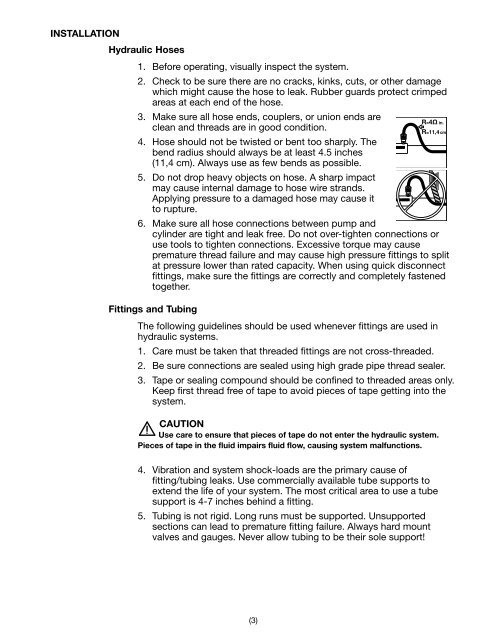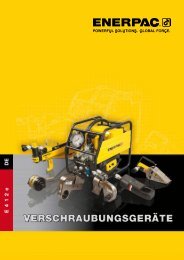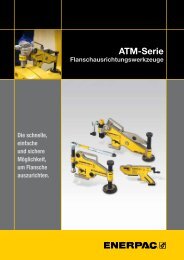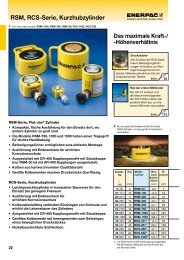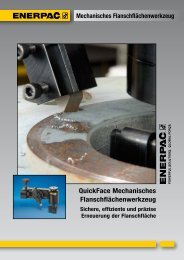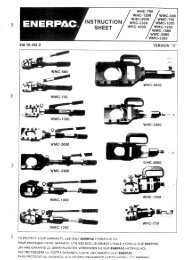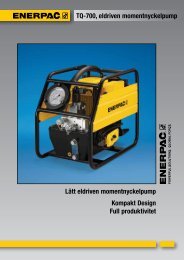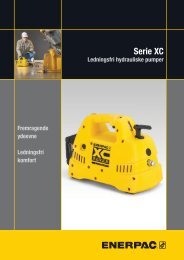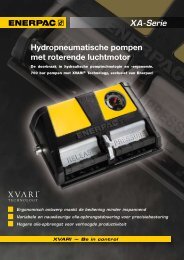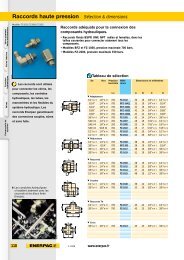Instruction Sheet Hydraulic Hose / Fittings - Enerpac
Instruction Sheet Hydraulic Hose / Fittings - Enerpac
Instruction Sheet Hydraulic Hose / Fittings - Enerpac
You also want an ePaper? Increase the reach of your titles
YUMPU automatically turns print PDFs into web optimized ePapers that Google loves.
INSTALLATION<br />
<strong>Hydraulic</strong> <strong>Hose</strong>s<br />
1. Before operating, visually inspect the system.<br />
2. Check to be sure there are no cracks, kinks, cuts, or other damage<br />
which might cause the hose to leak. Rubber guards protect crimped<br />
areas at each end of the hose.<br />
3. Make sure all hose ends, couplers, or union ends are<br />
R=4Ω in.<br />
clean and threads are in good condition.<br />
R=11,4 cm<br />
4. <strong>Hose</strong> should not be twisted or bent too sharply. The<br />
bend radius should always be at least 4.5 inches<br />
(11,4 cm). Always use as few bends as possible.<br />
5. Do not drop heavy objects on hose. A sharp impact<br />
may cause internal damage to hose wire strands.<br />
Applying pressure to a damaged hose may cause it<br />
to rupture.<br />
6. Make sure all hose connections between pump and<br />
cylinder are tight and leak free. Do not over-tighten connections or<br />
use tools to tighten connections. Excessive torque may cause<br />
premature thread failure and may cause high pressure fittings to split<br />
at pressure lower than rated capacity. When using quick disconnect<br />
fittings, make sure the fittings are correctly and completely fastened<br />
together.<br />
<strong>Fittings</strong> and Tubing<br />
The following guidelines should be used whenever fittings are used in<br />
hydraulic systems.<br />
1. Care must be taken that threaded fittings are not cross-threaded.<br />
2. Be sure connections are sealed using high grade pipe thread sealer.<br />
3. Tape or sealing compound should be confined to threaded areas only.<br />
Keep first thread free of tape to avoid pieces of tape getting into the<br />
system.<br />
CAUTION<br />
Use care to ensure that pieces of tape do not enter the hydraulic system.<br />
Pieces of tape in the fluid impairs fluid flow, causing system malfunctions.<br />
4. Vibration and system shock-loads are the primary cause of<br />
fitting/tubing leaks. Use commercially available tube supports to<br />
extend the life of your system. The most critical area to use a tube<br />
support is 4-7 inches behind a fitting.<br />
5. Tubing is not rigid. Long runs must be supported. Unsupported<br />
sections can lead to premature fitting failure. Always hard mount<br />
valves and gauges. Never allow tubing to be their sole support!<br />
(3)


